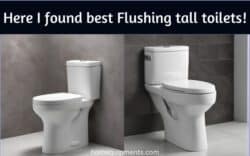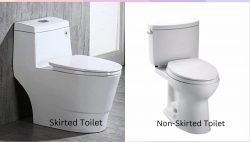Old Types Of Toilet Flush Systems: Tracing Bathroom Innovation History

When we think about toilets, we often take for granted the remarkable progress in plumbing technology that has brought us to where we are today. The journey from the old types of toilet flush systems to the modern, efficient designs we have now is a fascinating one.
Old flush toilets, also known as antique flush toilets, offer us a captivating glimpse into the past. In a world before our modern commodes, people faced a considerable challenge when it came to waste disposal. The concept of a flush toilet was a revolutionary breakthrough, providing a more sanitary and convenient alternative.
Historical Evolution of Flush Toilets
The historical evolution of flush toilets is a journey through time that spans thousands of years. Ancient civilizations had their own rudimentary versions of flush toilets, which laid the foundation for modern sanitation systems.
The Evolution of the Flush Toilet
When we think of toilets today, we often picture sleek, modern designs with efficient flushing mechanisms. But have you ever wondered about the origins of the flush toilet? The journey from the past to the present is nothing short of fascinating.
Ancient Beginnings
The concept of the flush toilet is ancient, dating back thousands of years. While the exact inventor remains a mystery, archaeological discoveries in northwest India hint at a drainage system that may have served as an early form of a toilet.
The Indus Valley Civilization,
Around 2500 BCE, is one of the earliest known societies to have had a form of flush toilets. These ancient toilets used gravity to remove waste through a network of underground drains.
The Greeks and Scots
Delving deeper into history, it appears that both the Scots and Greeks played a role in early toilet development. The Scots, in a Neolithic settlement around 3000 BC, and the Greeks at the Palace of Knossos in 1700 BC, had their own versions of early toilets. These toilets consisted of large earthenware pans connected to a flushing water supply.
Roman Lavatorial Culture
By 315 AD, Rome boasted an astonishing 144 public toilets. Romans had a unique approach to toilet time, treating it as a social event. They would gather, engage in conversations, catch up on news, and even use a sponge on a stick for cleaning. This practice, where the sponge was rinsed in a water channel in front of the toilet, may have given rise to the phrase “getting hold of the wrong end of the stick.”
Medieval Practices
In Medieval England, toilet practices were quite different. People used “potties” and disposed of waste by simply tossing it out of doors or windows onto the streets.
Those with means utilized “garderobes,” rooms with openings for waste disposal, often protruding over moats. The name “garderobe” likely originated from storing robes there to deter fleas and pests.
However, for peasants and serfs, communal privies at the end of streets were the norm. London even had a massive public garderobe that emptied directly into the River Thames, creating significant odor and health issues.
The Flush Revolution
While Thomas Crapper is often credited with inventing the flush toilet in the 1860s, the real credit belongs to Sir John Harrington. In 1592, he introduced a water closet with a raised cistern and a small downpipe for flushing.
In 16th century, and Sir John Harrington, an Englishman, designed a more sophisticated water closet for Queen Elizabeth I. His design incorporated a flushing mechanism using a valve and a wash-down bowl. Although his invention was not widely adopted, it was an important step forward in toilet technology.
In the 18th century, Alexander Cumming, a Scottish watchmaker, improved upon the S-shaped trap, which prevented foul odors from the sewer system from entering homes. This innovation marked a significant advancement in the comfort and cleanliness of indoor plumbing.
Victorian-Era Flush Toilets

The Victorian era, spanning from the early 19th century to the early 20th century, witnessed a significant transformation in flush toilet design and adoption. Flush toilets during this period went beyond mere functionality; they became ornate symbols of prosperity and modernity.
Flush toilets of the Victorian era were characterized by their meticulous craftsmanship and aesthetic appeal. Porcelain, a favored material for its durability and ease of cleaning, was often used in their construction. These toilets featured intricate patterns, engravings, and decorative elements that transformed a utilitarian fixture into a work of art.
In addition to their artistic qualities, Victorian flush toilets also represented a shift in societal values. As indoor plumbing became more common, the act of flushing waste away symbolized progress, cleanliness, and a departure from the more primitive methods of waste disposal that had been prevalent in earlier centuries.
The popularity of flush toilets during the Victorian era marked a turning point in the history of sanitation. They not only improved hygiene and public health but also reflected the changing attitudes towards personal comfort and modern living during this transformative period.
Sanitation Saves Lives
The 19th century brought rapid urbanization, but sanitation failed to keep pace. Overcrowded cities led to situations where up to 100 people might share a single toilet. Sewage often spilled into the streets and rivers, contaminating drinking water and causing waterborne diseases waterborne diseases. The “great stink” of 1858 finally prompted the construction of London’s sewer system in 1865, significantly reducing waterborne diseases.
The Flush’s Modern Evolution
In the 20th century, bathroom technology advanced rapidly. Flushable valves, water tanks integrated into the bowl, and the introduction of toilet paper rolls in 1902 marked milestones. Regulations like the U.S. Energy Policy Act of 1992 promoted water-efficient flush toilets.
Today, we have automatic flush systems, vacuum water closets, and even toilets that compost waste for garden use. The flush toilet has come a long way from its ancient origins, symbolizing the power of innovation and improved sanitation in transforming our lives.
The next time you use your modern flush toilet, take a moment to appreciate the journey it has undertaken—from ancient pots to cutting-edge commodes!
Materials and Design of Old Flush Toilets
The materials and design of old flush toilets provide insights into the craftsmanship and aesthetics of a bygone era. These toilets were not just functional fixtures; they were intricately designed pieces of household equipment.
Materials of old flush toilets:
Porcelain: Porcelain was a favored material for crafting old flush toilets due to its durability, smooth surface, and ease of cleaning. It allowed for intricate designs and could be adorned with decorative patterns and colors.
Metal: Some flush toilets, particularly older models, featured metal components, such as brass handles and fittings. These added a touch of elegance and durability to the toilets.
Old Flush toilets Design:
Ornate Patterns: Many old flush toilets boasted elaborate patterns and engravings. These decorative elements ranged from floral motifs to geometric designs, turning the toilet into a visually appealing fixture.
High Tanks: Some antique flush toilets had high tanks mounted high on the wall. These tanks were often elaborately decorated and connected to the bowl via exposed pipes, giving them a unique and distinctive appearance.
Wooden Seats: In some cases, flush toilets featured wooden seats, which added a warm, traditional touch to the design.
The combination of materials and design in old flush toilets was a testament to the craftsmanship and attention to detail of the artisans who created them. These toilets were not just functional; they were pieces of art that reflected the aesthetic sensibilities of their time.
Flush Mechanisms and Water Usage
Understanding the flush mechanisms and water usage of old flush toilets provides insight into how waste removal was managed in the past and the challenges associated with early sanitation technology.
Flush Mechanisms:
Pull Chains flush
Many early flush toilets utilized pull chains. Pulling the chain released water from the tank, flushing waste down the bowl. This mechanism required manual effort and coordination.
Lever-operated flush
Lever-operated flush mechanisms became more common in the 19th century. A lever, often located on the tank or bowl, would initiate the flush when pressed.
Foot Pedals Flush Toilet
Some innovative designs featured foot pedals, allowing users to initiate a flush without using their hands.
Water Usage:
Old flush toilets consumed significantly more water than modern ones. The flush tanks were larger, and the volume of water used per flush was substantial. This water-intensive design was less environmentally friendly and added to water bills.
Early flush toilets had tanks that could hold several gallons of water, whereas contemporary toilets use as little as 1.6 gallons per flush or even less for high-efficiency models. The excessive water usage of old flush toilets was a concern for conservation and utility costs.
Understanding these flush mechanisms and water usage helps us appreciate the advancements made in modern toilets, which prioritize water conservation and efficiency while still effectively removing waste.
During the Victorian era in the 19th century, flush toilets began to gain popularity in households. These toilets were not just functional; they were also artistic masterpieces. Crafted with intricate patterns and engravings, they became status symbols, reflecting the progress and sophistication of the time.
Sanitation and Public Health Impact
Before flush toilets, cities struggled with sanitation issues. Waste accumulation in streets and homes led to the spread of diseases. The advent of flush toilets played a pivotal role in improving public health by effectively removing waste and minimizing the risk of contamination.
Transition to Modern Flush Toilets
The transition from old flush toilets to modern ones represents a remarkable advancement in sanitation technology. Modern flush toilets incorporate innovative features that enhance efficiency, water conservation, and hygiene.
Two primary flushing systems dominate the modern toilet landscape: siphon and pressure-assist systems. These systems use less water while maintaining effective waste removal. The shift towards water-efficient designs is especially important in an era where environmental sustainability is a priority.
Modern toilets also prioritize user comfort and convenience. Ergonomic seat heights, easy-to-clean surfaces, and concealed trapways improve the overall user experience. Additionally, features like rimless bowl designs and self-cleaning mechanisms reduce manual maintenance efforts.
Furthermore, dual-flush toilets, which offer different flush options for liquid and solid waste, empower users to control their water consumption. This transition to modern flush toilets not only benefits households but also contributes to water conservation efforts and environmental protection.
Legacy of Old Flush Toilets
The legacy of old flush toilets is enduring and multifaceted. These early innovations, though outdated, continue to influence modern sanitation and historical understanding.
First and foremost, old flush toilets are a testament to human ingenuity in solving essential everyday problems. They represent a pivotal moment in the history of sanitation, where people sought cleaner and more efficient ways to manage waste.
Additionally, the challenges faced with old flush toilets spurred further innovation and the development of modern flush toilet technology. The need for improved water efficiency, reduced maintenance, and enhanced user comfort were all born out of the shortcomings of early designs.
Old flush toilets also have a cultural legacy. They are artifacts that provide insight into the lifestyles and priorities of past generations. Ornate and decorative designs of antique flush toilets reflect the aesthetic sensibilities of their time.
In the bottom line, while old flush toilets have largely been replaced by modern counterparts, their legacy lives on in the form of improved sanitation, lessons in innovation, and artifacts that offer a glimpse into the history of human hygiene.
Conclusion: The Enduring Influence of Antique Flush Toilets
Antique flush toilets may seem like relics from a distant era, but they remain integral to our history. They remind us of the remarkable progress made in sanitation technology and serve as a reminder that even the most mundane aspects of our lives have rich and intriguing stories to tell.
In essence, they are a testament to human innovation and the ever-evolving quest for a cleaner, healthier, and more efficient world.





